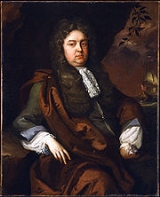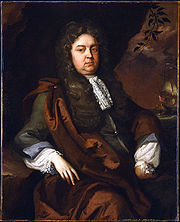
John Berry
Encyclopedia

Kingdom of England
The Kingdom of England was, from 927 to 1707, a sovereign state to the northwest of continental Europe. At its height, the Kingdom of England spanned the southern two-thirds of the island of Great Britain and several smaller outlying islands; what today comprises the legal jurisdiction of England...
naval officer of the Royal Navy
Royal Navy
The Royal Navy is the naval warfare service branch of the British Armed Forces. Founded in the 16th century, it is the oldest service branch and is known as the Senior Service...
, and was in 1675 the captain of the annual convoy to Newfoundland that took place during the years of the colony's founding.
Berry's advocacy of the right of the small number of settlers to remain in Newfoundland, which was opposed by the British Committee for Trade and Plantations, was an important factor in determining the future course of European settlement in Newfoundland.
Soon after British annexation
British colonization of the Americas
British colonization of the Americas began in 1607 in Jamestown, Virginia and reached its peak when colonies had been established throughout the Americas...
of the Dutch province of New Netherland
New Netherland
New Netherland, or Nieuw-Nederland in Dutch, was the 17th-century colonial province of the Republic of the Seven United Netherlands on the East Coast of North America. The claimed territories were the lands from the Delmarva Peninsula to extreme southwestern Cape Cod...
in 1664, Philip Cartaret
Philip Carteret (Governor)
Philip Carteret was the first and fourth British colonial governor of New Jersey, from 1665 to 1672 and from 1674 to 1682.The English annexed the Dutch province of New Netherland in 1664, and lands west of the Hudson River were awarded to two Lords Proprietors, John Berkeley and George Carteret...
, governor of what became the proprietary colony
Proprietary colony
A proprietary colony was a colony in which one or more individuals, usually land owners, remaining subject to their parent state's sanctions, retained rights that are today regarded as the privilege of the state, and in all cases eventually became so....
of East Jersey
East Jersey
The Province of East Jersey and the Province of West Jersey were two distinct, separately governed parts of the Province of New Jersey that existed as separate provinces for 28 years, between 1674 and 1702. East Jersey's capital was located at Perth Amboy...
, granted land to Captain John Berry
John Berry
Sir John Berry was an English naval officer of the Royal Navy, and was in 1675 the captain of the annual convoy to Newfoundland that took place during the years of the colony's founding....
in the area known as Achter Kol He soon took up residence and called it "New Barbadoes
New Barbadoes Neck
New Barbadoes Neck is the name given in the colonial era for the peninsula in northeastern New Jersey, USA between the lower Hackensack and Passaic Rivers, in what is now western Hudson County and southern Bergen County...
," having previously resided on the island of Barbadoes. The land patent encompassed area between the Hackensack River
Hackensack River
The Hackensack River is a river, approximately 45 miles long, in the U.S. states of New York and New Jersey, emptying into Newark Bay, a back chamber of New York Harbor. The watershed of the river includes part of the suburban area outside New York City just west of the lower Hudson River,...
and Saddle River
Saddle River
Saddle River may refer to:Places:*Saddle River, New Jersey, a borough in Bergen County, New Jersey*Saddle River , a tributary of the Passaic River in New Jersey...
in what is now Bergen County, New Jersey
Bergen County, New Jersey
Bergen County is the most populous county of the state of New Jersey, United States. As of the 2010 United States Census, its population was 905,116. The county is part of the New York City Metropolitan Area. Its county seat is Hackensack...
.
From 1672–1673, Berry was the Governor of the Province of New Jersey
Province of New Jersey
The Province of New Jersey was one of the Middle Colonies of Colonial America and became the U.S. state of New Jersey in 1776. The province had originally been settled by Europeans as part of New Netherland, but came under English rule after the surrender of Fort Amsterdam in 1664, becoming a...
. He is recalled in the name of a stream in the New Jersey Meadowlands
New Jersey Meadowlands
New Jersey Meadowlands, also known as the Hackensack Meadowlands after the primary river flowing through it, is a general name for the large ecosystem of wetlands in northeast New Jersey in the United States. The Meadowlands are known for being the site of large landfills and decades of...
, Berrys Creek
Berrys Creek
Berrys Creek is a tributary of the Hackensack River in the New Jersey Meadowlands in Bergen County, New Jersey.-Geography:...
, and the historic Yereance-Berry House
Yereance-Berry house
The Yereance-Berry House is a stone house built in the early 19th century in what is now Rutherford, New Jersey. It was placed on the National Register of Historic Places on January 10, 1983 and is currently home to the Meadowlands Museum....
.

